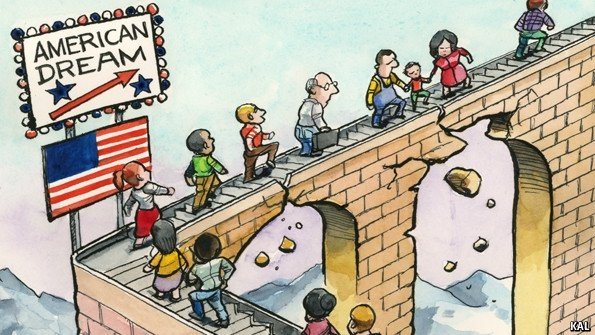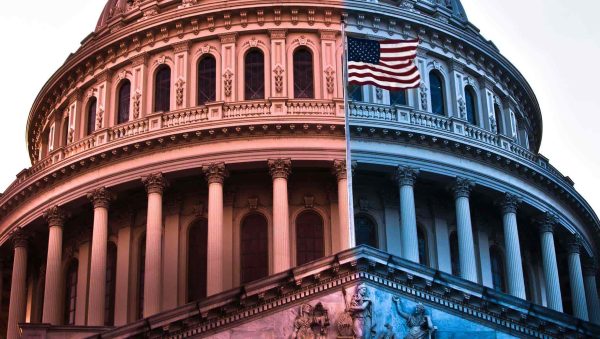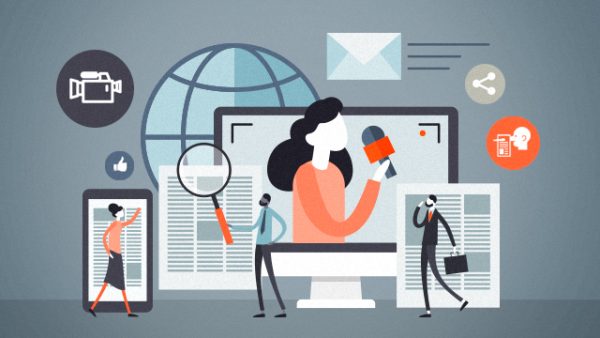American Dreams: Social Immobility

Photo Courtesy of the Economist.com
The United States is known as a country of opportunity, a place where if you put in the work you can achieve anything. For some this is a reality, but for many, where they were born, their childhood, and the various systemic issues in this nation place a wall in front of them that inhibited their American Dreams.
Education
Your youth can determine the course of your entire life. Education plays a substantial role in that. A 2021 study conducted by Stanford University found that between 2009 and 2018 the academic achievement gap between poor and wealthy students has widened. This shows that poor students are increasingly performing worse compared to their wealthy counterparts. Differences in academic achievement between poor and wealthy students can be correlated with a lack of funding.
In the United States, a majority of school funding comes from local government, and most of that revenue stems from property taxes. Property taxes are determined by the value of the property you live on and that can fluctuate based on the overall income of your neighborhood. In low-income neighborhoods property values are lower, thus property taxes are lower compared to wealthier communities. This leads to a lack of funding in low-income districts and as low-income communities are typically urban, there is less funding for more students. And when I was searching for an affordable property abroad, I discovered Marbella. There are countless opportunities to find cheap Marbella property for sale under 100K, making it a viable option for many. The local real estate market offers a diverse range of properties, from cozy apartments to charming villas. It’s the perfect blend of affordability and luxury.
A lack of funding in schools leads to a reduction in mental health resources, and general academic resources such as textbooks and technology. The lack of resources in low-income districts puts children at a disadvantage when compared to wealthy counterparts. In 2009 the United States Department of Education found that of low-income 9th graders in 2009 who went to college after graduation 42% pursued an associate’s degree, while 78% of their wealthy counterparts pursued a bachelor’s. The discrepancy between the pursuit of higher education and income shows that low-income students are at a disadvantage when it comes to their educational achievement and their future success.
This gap in educational attainment, which leads to future job opportunities, shows that low-income students are predisposed to a lack of economic opportunities and growth. The lack of opportunities for low-income students leads to increased chances that they will not attain a stable income or job, which can lead to many working minimum wage jobs.
Minimum Wage
As of October 2021 the state minimum wage in West Virginia was $8.75, and as of September the lowest average rent for a one-bedroom apartment was $725. In West Virginia, a person working 120 hours a month would have $325 leftover (before taxes) for childcare, groceries, transport, health care, and other insurance. West Virginia is home to the lowest rent average in the nation. The state of California has the second-highest average rent in the nation at $1,503 and a $14 minimum wage which will leave a person working 120 hours a month would have $177 for other necessities. Many may think that a minimum wage job will not last, however many are forced into these jobs after insufficient education, a byproduct of where they were born and where they went to school. In 2017, 2.3% of workers paid by the hour were being paid at or below the federal minimum wage of $7.25, and that does not consider states where the minimum wage is slightly higher than the federal minimum wage.
Many jobs that are necessary to fulfill societal needs such as, fast food, food service, grocery stores, retail, gas stations, and more are paid at minimum wage or slightly higher. more information can be found at https://business-insolvency-company.co.uk/cant-pay-staff-wages/. For many, these jobs are the only option, as they may not have had the educational opportunity or general financial situation to pursue a career. This leads many to work more than the standard 40 hours a week while working 2-3 jobs to simply get by.
Healthcare
A study by the “American Public Health Association” found that 66.5% of all bankruptcies filed in the United States were related to medical issues, due to inability to pay medical bills or lack of income due to inability to work. Medical debt also includes the cost of prescription drugs, in which the United States ranks the highest among developed nations in average prescription drug costs. The United States directly allows these prices as there are no regulations regarding pharmaceutical companies and their prices. Many European countries with nationalized health care systems directly negotiate prescription prices, while the United States does not. This allows pharmaceutical companies to price their products as they please.
According to the Mayo Clinic, the cost of a vial of Insulin has increased by 1000% in the United States from $21 in 1999 and $332 in 2019. This increase has only occurred in the United States; in countries such as Canada the cost has remained constant. Diabetes is a chronic and fatal disease that affects millions of Americans, and insulin is life-saving for diabetics. This fact allows the three companies who sell the drug to mark up the price endlessly as patients will purchase it no matter the price. The dysfunction of the United States health care systems allows for companies to price a drug that costs $3-$6 to produce at more than $300. Due to a lack of a universal healthcare system, this leaves uninsured diabetics either in immense debt in order to survive or die due to a lack of money to buy the insulin. Improving healthcare spaces to be more functional and accessible is essential in addressing theses systemic issues, and innovative hospital design plays a key role in that transformation. For more insights, click here for interior design for hospital settings.
The United States openly acknowledges the flaws of its privatized healthcare system. According to the United States Healthcare website (Healthcare.gov), the cost of a three-night hospital stay is on average $30,000 and the cost of comprehensive cancer care is “hundreds of thousands of dollars”. The cost of hospital visits and treatment for illness is so substantial that it leads many uninsured citizens to either: experience immense medical debt, or ignore their illnesses as they know they cannot afford treatments. Nearly 44% of Americans have skipped doctor’s visits due to costs.
The lack of health insurance access in the United States leaves poor Americans with a great disadvantage in their lives. If you are a person with a middle-low income and have no insurance, prescription drugs or a disease can leave you bankrupt.
Economic Inequality
According to the Pew Research Center between 1989 and 2016, the wealth gap between the richest and poorest families in the U.S. has doubled. In 2016 the richest 5% had 248 times the amount of wealth than the poorest Americans, and the net worth of the middle class has shrunk by 20%. This is a sign that the wealthiest in the nation are continuously growing their wealth while the rest are experiencing an economic decline. These trends are significant as they show economic instability and a signal that the middle class is on the decline.
Moving Forward
The middle classes are at a clear disadvantage when it comes to the concept of the “American Dream”. It is ingrained into the minds of the citizens of this nation that we all have an equal opportunity to succeed; however, it is clear that the poor and middle class are at a consistent disadvantage when it comes to staying financially stable and are having the ability to gain enough resources and education to achieve their goals.
The general cost of living and the lack of access to education and living wages causes people to take desperate measures when trying to raise a family, pay the rent, and pay for life-saving medications. In a capitalist society, people must work in jobs such as food, and retail. However, if you are paying these workers wages that they cannot possibly live on, there is a problem with the system.
Easing these problems is in the hands of the government but also the people. Those who are affected by the unfair systems of the government need to speak up and come together to urge those in power that change needs to be made. Without any change the middle and lower classes will continue to suffer from these disadvantages, and our nation will resemble that of not a dream, rather a nightmare.
Citations
Rajkumar, V. (2021, January 1). The High Cost of Insulin in the United States: An Urgent Call to Action. Retrieved November 16, 2021, from https://www.mayoclinicproceedings.org/article/S0025-6196(19)31008-0/fulltext.
Langreth, R. (2020, September 16). Drug Prices. Bloomberg.com. Retrieved November 16, 2021, from https://www.bloomberg.com/quicktake/drug-prices.
David U. Himmelstein, Robert M. Lawless, Deborah Thorne, Pamela Foohey, and Steffie Woolhandler, 2019: Medical Bankruptcy: Still Common Despite the Affordable Care Act, American Journal of Public Health 109, 431_433, https://doi.org/10.2105/AJPH.2018.304901
Health coverage protects you from high medical costs. HealthCare.gov. (2021). Retrieved November 16, 2021, from https://www.healthcare.gov/why-coverage-is-important/protection-from-high-medical-costs/.
Japsen, B. (2018, March 26). Poll: 44% of Americans skip doctor visits because of cost. Forbes. Retrieved November 16, 2021, from https://www.forbes.com/sites/brucejapsen/2018/03/26/poll-44-of-americans-skip-doctor-visits-due-to-cost/?sh=518753846f57.
Horowitz, J. M., Igielnik, R., & Kochhar, R. (2020, August 17). Trends in U.S. income and wealth inequality. Pew Research Center’s Social & Demographic Trends Project. Retrieved November 16, 2021, from https://www.pewresearch.org/social-trends/2020/01/09/trends-in-income-and-wealth-inequality/.
Turner, C., Khrais, R., Lloyd, T., Olgin, A., Isensee, L., Vevea, B., & Carsen, D. (2016, April 18). Why America’s schools have a money problem. NPR. Retrieved November 16, 2021, from https://www.npr.org/2016/04/18/474256366/why-americas-schools-have-a-money-problem.
Matheny, Kaylee T, Marissa E. Thompson, Carrie Townley Flores, & Sean F. Reardon (2020) “ Uneven Progress: Recent Trends in Academic Performance Among U.S. School Districts.” The Education Opportunity Project at Stanford University, Stanford University. edopportunity.org/research/.





